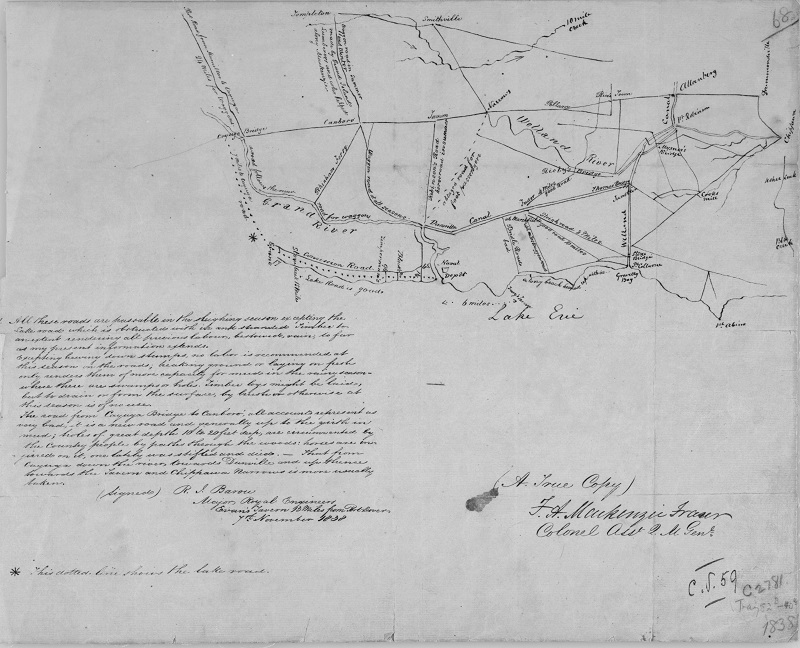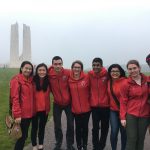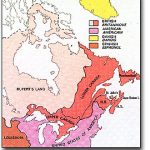
Grade 7 History, UNIT 2 – 1800-1850: CONFLICT AND CHANGE
LESSON TITLE : The Transformative Power of Transportation
TIME: 80 minutes (two class periods)
This lesson will centre on a variety of aspects of the growing transportation networks in upper Canada between the war of 1812 and Confederation. Students will have the opportunity to look at need for, development of and finally reflect on the effects of the new transportation network first from the perspective of the European colonists and then from that of the First Nations people.
EXPECTATIONS:
- Students will recognize the shift from individual road building responsibilities to the more top down planning of transportation routes we are more familiar with today.
- Students will demonstrate an understanding of the importance of roads to the settlers of Upper Canada, why they were important and how they were built.
- Students will be able to identify multiple factors, both internal and external, that would have influenced road construction both in terms of planning the routes as well as the building itself.
- Students will understand the effect that roads had on First Nations populations. Students will demonstrate an understanding of how the increase in transportation would have affected their territory, way of life and role in the new economic system.
ASSESSMENT:
- Two written pieces which will be started in groups as graphic organizers and then completed at home in the form of a reflection.
- Small group presentations will demonstrate understanding of the assigned reading.
PLANNING NOTES:
- Laminated historical maps of Upper Canada will be needed. Crayons can be used on the plastic and then wiped off after the exercise is completed allowing the maps to be reused. Ensure there is somewhere that the maps can be stored undisturbed between classes.
- The University of Guelph has a digital archive of rural diaries (See resources). Preselecting excerpts which touch on roads and transportation will allow students to experience primary documents and voices from the past. These can be paired with excerpts from text books which will provide them with enough details for their presentation and reflections.
- Access to computers of some form would allow groups to extend their investigations if time allows.
PRIOR KNOWLEDGE REQUIRED (of STUDENTS):
Students should be comfortable with the early developments of Upper Canada and more specifically the relationship prior to and during the first half of the 19th century between the European settlers and the First Nations people. Students should have some level of comfort with the difference between primary and secondary documents and be comfortable attaining information from both. Although not necessarily needed to understand the main concepts some understanding of the changing role of British involvement in Upper Canada after the War of 1812 would give the greater perspective on the period of transportation development they are investigating.
ACCOMODATIONS/ MODIFICATIONS:
Much of the work will be done in groups which can be pre-planned if the teacher feels this would better serve the class. Group members can support one another and for the independent writing students can have access to computers or have adjusted expectations in their success criteria for those with IEPs.
RESOURCES:
Rural Diary Archive:https://ruraldiaries.lib.uoguelph.ca/
TEACHING / LEARNING TASKS/ DURATION (APPROX):
Class #1 (5-10 minutes)
Teacher Presentation
A brief presentation by the teacher will provide some of the context around the period of time and the region to be investigated. Mostly this will ensure that all of the students are comfortable with the prior knowledge needed for the next two classes.
Mini Group Investigation (10 minutes to investigate + 10 minutes to present)
Students will divide into groups where they will be assigned readings (one primary and one secondary document) which they will use to investigate an individual and the societal group they represent (farmers, clergy, merchants, military/militias). The focus of the readings will be on road development and the varying needs for using and responsibilities of building and developing roads. Using short preselected readings students will fill out graphic organizers present their findings to the class.
Map Simulation (10 minutes)
For this activity new groups will be made comprised of one member from each of the investigative groups. Group members will play the role which they had previously investigated. Using what they know of their character’s needs and road responsibilities they will build roads in lengths based on the luck of a dice role. Students will have a preselected number of turns (mostly based on time).
Once the turns have been completed and the roads and cleared land have been drawn on the map groups will put the maps away in a pre-assigned location where they will be stored until the next history class.
Class #2
Worksheet (10 minutes)
Students will each be given a small reading detailing a First Nation including their original home territory as well as their traditional food sources (hunting, fishing, cultivation, etc.). Once they have completed a basic work sheet they can move on to the mapping activity.
Map Simulation Part 2 (10 minutes)
Using the information from their worksheets students will take turns drawing their territories on the map. In a different colour from the roads students will draw the necessary transportation routes the First Nation would need to acquire their own food, connect with other First Nations and depending on the assigned tribe connect with the European settlements for trade. The twist will be that no First Nation territory can cross a European roadway and no First Nation route can cross “private” European land.
Group Discussion (10 minutes)
Students will be asked to reflect on how the European establishments and roadways would have affected each of the First Nations’ way of life. Thinking back to when they were in the role of colonists students will also reflect on what they may have done differently in regards to their road and territorial development had they been aware of and had a better understanding of the First Nations people from that area as well as their needs and traditions.
Group Presentation (10 minutes)
Each group will present the two or three most important or impactful things that came from their reflections on the activities. Each presentation should have at least one point on the effects that the road development would have had on the First Nations population.
HOMEWORK:
- After the first class students are to write a reflection on the role roads played in the lives of colonists in Upper Canada. This should build off of their initial investigation and their role in the map simulation.
- After the second class, students are to write a more extensive reflection looking more specifically at how the European development would have affected the First Nations people’s way of life. As an extension to the assignment students will be asked to come up with a modern example of the greater effects of developing or destroying transportation networks. Students will have access to photos of their map simulations as well as all of the readings and information sheets through Google classroom.


